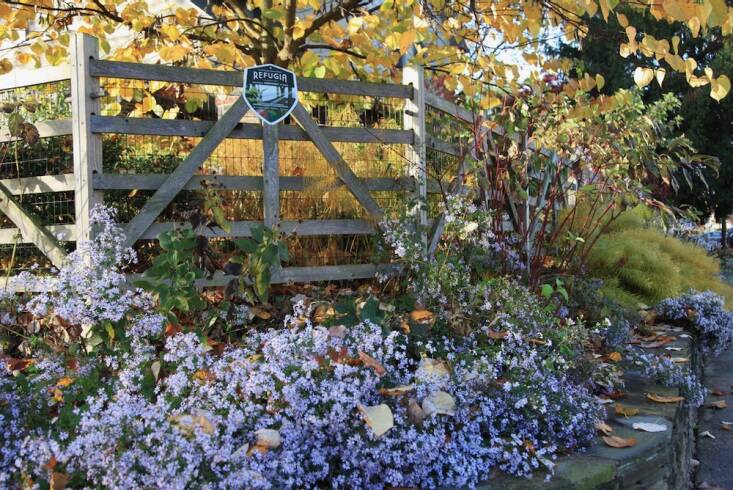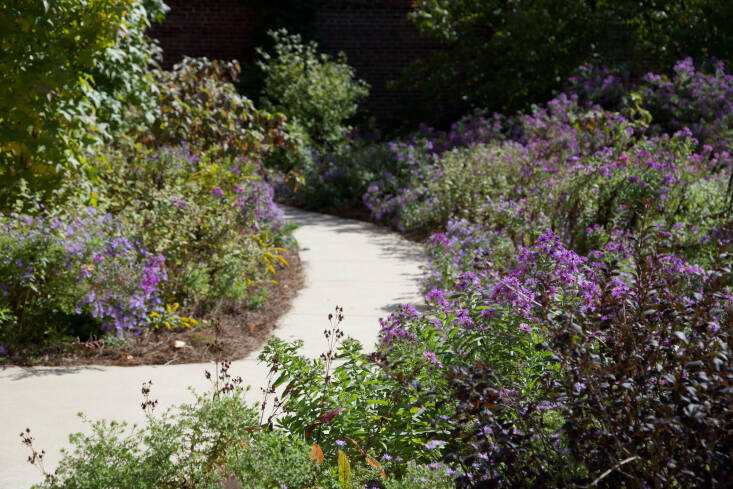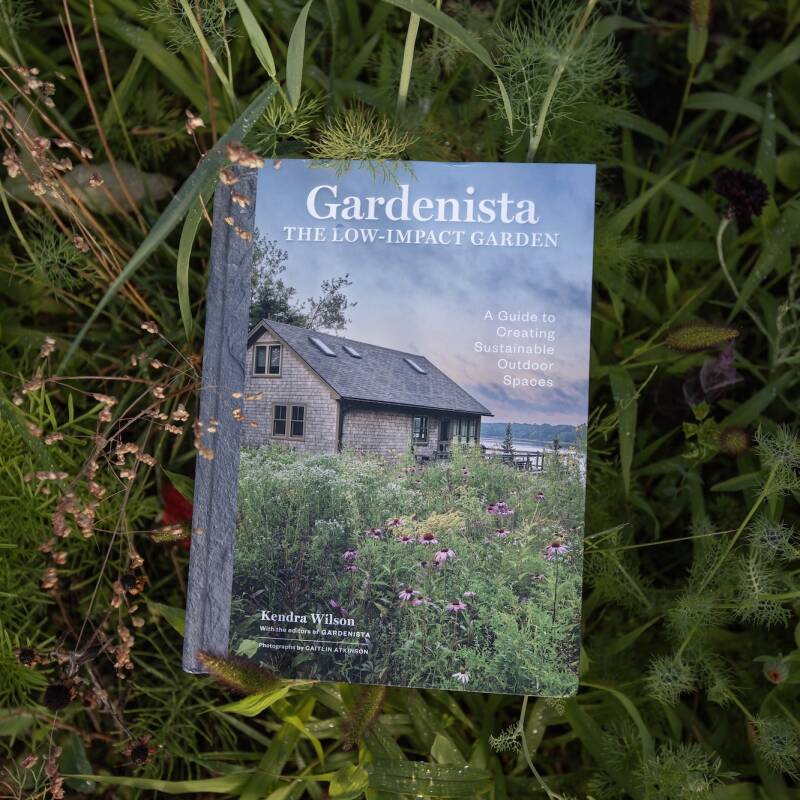Last Friday’s torrential rains made the journey to the New York Botanical Garden a harrowing one. As ticket holders arrived to The Garden Conservancy’s first annual Garden Futures Summit late and rain-soaked, it was a visceral reminder of some of the issues on the docket for the event. The Garden Futures Summit centered around three themes: environment, community, and culture, culminating in a keynote about ecological restoration by Isabella Tree, the British conservationist, journalist, and author of the recently published The Book of Rewilding. [Check back on Thursday for more on the book.] The garden of the future that this event imagined is one that is changing—but also a vehicle for needed change. Here are 10 ways the experts see gardens evolving:
1. Gardens will be everywhere.

You don’t need to convince a room full of garden enthusiasts that green space is essential, but the summit speakers argued for the assembled guests to advocate for more gardens in public spaces, not just on private properties. Horticulturist and landscape designer Rebecca McMackin said, “We need more gardens outside of gates and fences—ones that are part of the fabric of our daily lives.” Presenting her recent design for the Brooklyn Museum with Brook Klausing of Brook Landscape, McMackin said, “I’m so proud of this garden because it’s a garden for the people waiting at the bus stop. This is a garden for the hotdog vendor.” Adam Greenspan of PWP Landscape Architecture and Peter Lefkovits of Skidmore, Owings & Merrill shared their already-built designs for garden airports in Bangalore and Singapore. Vanessa Keith, founder of StudioTEKA, an architect whose work imagines the built environment of the future, shared images from her Year2180Game in which an imagined New York City of 2100 appears dripping with plants.
2. Aesthetics will continue to evolve.

The presentations were full of gardens that exemplified how garden aesthetics have already shifted to favor more native and drought-tolerant plants and a looser aesthetic. Horatio Joyce, the Garden Conservancy’s director of public programs and education posited, “At every great aesthetic turn in gardening there has been garden visiting.” As the Grand Tours of the 17th and early 18th century led to the English garden aesthetic, so too, might today’s public gardens like the High Line and the private gardens of the Conservancy’s Open Days programs, including their “nibbled leaf” pesticide-free gardens, influence amateur green thumbs. “The more people see this, the more it can become the new normal,” said Jeff Lorenz, founder of Refugia Design, a native landscape design-build firm in the Philadelphia area.
3. We’ll start to think of gardens as a network.

Panelists spoke on the urgent need to reconnect fragmented green spaces, and how one garden moving to more ecological and climate-friendly practices can cause a ripple effect within a neighborhood. Not only will gardeners create this new network of habitat, Lorenz hopes they will communicate it to the world through signs like the ones his firm provides its 200+ native landscape clients, which are considered part of the Refugia Greenway Network in Pennsylvania, Delaware, and New Jersey or nationally through etymologist and conservationist Doug Tallamy’s Homegrown National Park’s yard signs and similar programs. (Event sponsor Perfect Earth Project recently launched their Living Lands program to teach homeowners, garden designers, and landscapers how to transition to nature-based gardening practices, which will help habitat networks grow and flourish.)
4. Future landscapes will prioritize function.
Of the many words and phrases that bubbled up again and again, “function” might have been the most repeated. Many panelists spoke about the importance of “ecological function,” an especially poignant concept given the storm raging outside the auditorium. Lorenz talked about his firm’s schemes for rain gardens that help manage stormwater runoff. Keith painted a picture of buildings of the future designed to function as wildlife habitats, like the bus shelter rooftops turned into butterfly gardens in the U.K.
5. Gardens will need to be able to handle intense rains…

As phones chorused flash flood warnings in unison, rain was on everyone’s mind. In addition to Lorenz’s advice about how gardens can help manage increasingly intense rains, Cindy Brockway, managing director of cultural resources historic collections for The Trustees of Reservations, a nonprofit that manages 123 properties in Massachusetts, revealed that at one of their historic home properties, she was no longer aiming for historical accuracy in the gardens, but rather looking to see what plants had survived 2022’s summer of drought and 2023’s summer of intense rains. “The garden is telling us what it wants to be,” Brockway said.
6. …and drought, too.

On the flip side of too much rain, the experts warned gardeners that we need to start planning now for less water available to us in the future. Panel host Edwina von Gal shared her worries about the rate at which we are using up our groundwater. David Godshall of Terremoto presented a reimagined garden for an iconic midcentury home by A. Quincy Jones that eschewed the water-hungry Japanese garden full of azaleas for a new understory of drought-tolerant plants that are 60-percent California natives. Isabella Tree, whose latest addition to her estate is a xeric garden with more than 900 types of plants from around the globe, was more blunt. “We’ve got to stop watering our gardens,” Tree said. “It is an indulgence we can no longer afford.”
7. The conversation around native plants will be more nuanced.
While enthusiasm for native plants abounded, the experts suggest gardeners (and the media) need to move away from a dogmatic doctrine of only native plants–both to eliminate the shaming of gardeners who might still want to grow dahlias and roses, but also because in a rapidly changing climate, we may need to be more open-minded about what plants are suitable for our regions. Abra Lee, the director of horticulture at Oakland Cemetery, also spoke to the danger of demeaning plants, citing the example of English ivy, an aggressive spreader and also the symbol of the Black sorority Alpha Kappa Alpha. Lee leaves the ivy growing on the grave of the sorority’s founder Marie Antoinette Woolfolk, because of its symbolic significance to the Black community.
At the same time, gardeners will likely become more discerning about the sources of our native plants. McMackin wondered aloud about the long-term sustainability of cultivars of echinacea, grown in the midwest and shipped to New York City. McMackin also acknowledged that may be the best option available: For her own recent project it was impossible to find straight species native plants, so she used more readily available cultivars.
8. Historic gardens will not be preserved in amber.

Godshall described Terremoto’s work to revive the landscape around the communal buildings at Sea Ranch, a private community on the National Register of Historic Places, as utilizing both “reverence and recklessness.” Another speaker from the Culture panel, Brent Leggs, who is the executive for the National Trust’s African American Cultural Heritage Action Fund, explained the Trust’s approach to preserving the home of John and Alice Coltrane, where there is little evidence of the original landscape: The Trust contracted Nelson Byrd Woltz Landscape Architects to develop a landscape plan that is “a reflection of the Coltranes’ contributions to music and culture.” While at other properties, the Trust is striving to preserve the vernacular landscape, which Leggs says we must value equally with high-design landscapes.
9. The way we talk about gardens will change.
All the experts agree that native plants are vitally important to our future gardens, but McMackin also spoke about the need to shift the way we speak about native plants and invasives, pointing to the cautionary tale of Europe where these ideals have been used to promote nationalism and xenophobia. Instead of emphasizing “native” plants, McMackin says she likes to talk about “local” plants and “ecological function,” which encourages gardeners to think about plants more deeply.
10. Gardeners will examine the industry more deeply.

Terremoto’s Godshall included images not only of his firm’s landscapes, but also of the workers installing them, saying, “Landscape labor is rendered invisible in our current media, and that needs to change.” Von Gal pointed to homeowners waking up to the true cost of the stereotypical lawn, which while relatively affordable to install is one of the most expensive to maintain over time. McMackin urged gardeners to get to know their growers and ask themselves how they are growing their plants (Do they grow locally? Do they use neonics?) and how they treat their workers. She also longs to see more gardeners collecting seeds and growing their own plants.
In short, these experts see our relationships with our gardens becoming richer, deeper, and more filled with meaning. It’s a vision of the future any gardener is sure to embrace.
See also:
- The Future of Gardening: A Plan From Terremoto
- Garden Visit: Refugia’s Quiet Revolution in Philadelphia’s Suburbs
- ‘Stop Putting Your Garden into Shapewear’: 12 Tips for Nature-Based Gardening













Have a Question or Comment About This Post?
Join the conversation (1)